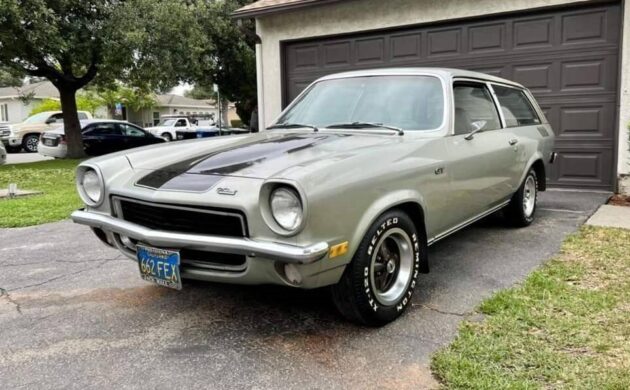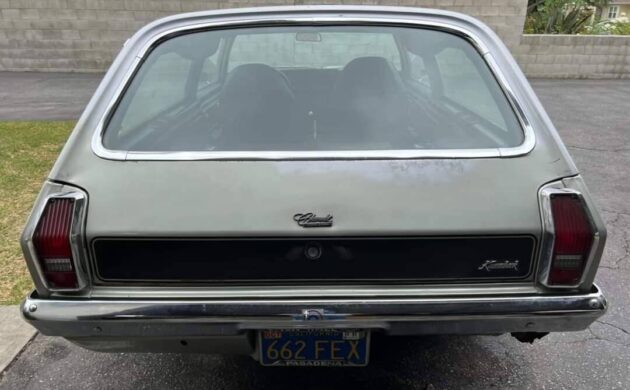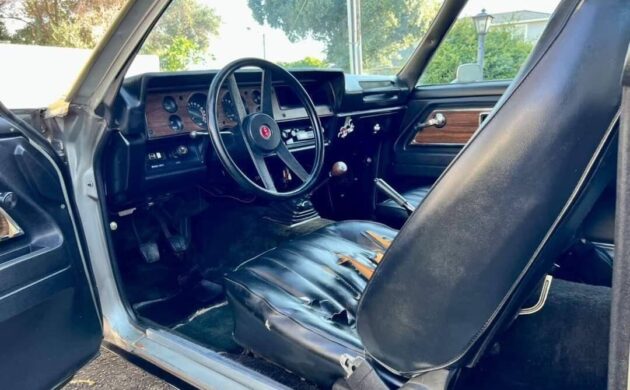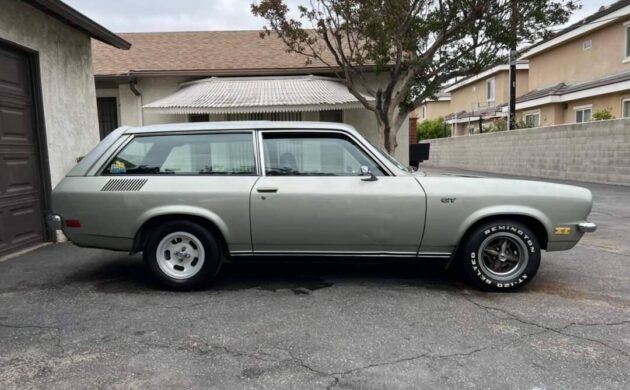Introduced in 1971, the subcompact Chevy Vega should have been a winner. A lot of planning went into the new car, but Chevy dropped the ball in terms of quality control, so they developed an initial bad rap. With that being said, more than two million units were produced before GM moved on from the car after 1977. This 1972 edition is both a GT and a Kammback (aka station wagon) and looks mostly original after 50 years. From Temple City, California, this survivor is available here on craigslist for $6,500. Another cool top from Barn Finder Pat L.!
A lot has been written about the overheating engines in the Vega or their problems with premature rusting. But there were some cool things that GM came up with the advent of the Vega, too. For example, to improve how the cars would be shipped to dealerships, they developed the Vert-A-Pac, a specially modified railroad flat car. It used a row of bottom-hinged doors on each side which formed a ramp when opened. The Vega’s were driven onto the ramp and bolted down using sockets on the frame rails. Once all the cars were loaded, a forklift lifted and closed the doors, tilting the Vegas onto their noses. 15 of the cars could be packed in on each side, for 30 cars per loaded flatcar, double that of the prior method.
Other than the performance version that came later – the Cosworth – perhaps the most interesting Vega was the Kammback, a small 2-door wagon that could also be had as a panel delivery van. In its second outing in 1972, the Kammback would sell nearly 72,000 units plus another 4,000 panels. Over the car’s seven-year odyssey, the Kammback would account for 468,000 units, nearly a quarter of all Vega production. Yet, with all those wagons ordered, you seldom see any of them these days. An exception would be the seller’s 1972 model, even with its mismatched wheels.
The body, paint, and stripes on this wagon look nice and the finish is original. We’re told the interior has original materials, too, although the seller’s bucket seat looks to need redoing. The GT model didn’t benefit from any performance upgrades but did have some suspension mods and a higher level of trim. The odometer may have turned over, maybe rare for a Vega, and the seller tells us the original 140 cubic inch engine resides under the hood with a 4-speed manual. The seller adds that the car “runs and drives” but uses no adjectives to describe how well, so we have to assume it’s not perfect. You might find a nicer Vega out there, but you’d have to look really hard.






These are really good looking cars. It’s too bad they had so many flaws. Our neighbor bought a new ’72 GT that in the first 6 months spent more time at the dealer’s shop chasing down engine problems than being at his home. It also came with factory rust and corresponded with our ’72 Blazer with the same problem. At least the Blazer’s running gear didn’t miss a beat during the 60,000 miles we owned it.
I’m with bobhess, these were good-looking economy cars, but had too many problems. Good to see one which survived.
My only experience with the Vega was helping my college roommate replace the clutch in his at 30k miles. We did it in the gravel parking lot at school. It was NOT a fun job!! He knew just enough of how to do it to be dangerous. I was manual labor. Somehow, we got it done.
Looks good. Has potential.
My Vegamatic experience involved two, my friends 74 wagon that I actually got a speeding ticket in and my brother in law’s that smoked so bad after 50 thousand miles that we did the best thing we could think of, installed a Toyota 22R (I think) engine.
A speeding ticket – downhill with a tailwind? :)
The GT model looked good, but in reality they were terrible cars. I had a neighbor who had one in the mid 1970’s. It ended up being a nightmare of problems for him. Car ended up being a ornament piece on the street that everyone sat on for years.
I had one when I was in the navy drove it from Kansas City to San Diego and back don’t know how I made it
Oftentimes, keeping a car original may be the proper thing to do. But these really do beg for the SBC treatment.
When my brother & I were in tech school in Tennessee, back in ’82, blown-up Vegas were cheaper than a dime-a dozen. During open shop, no fewer than four guys 350’d them. A wagon, 2 hatchbacks & a panel. Bob upgraded his 305 Monza (basically the same car, bad cam) to a 350 (more work than you might think, especially to keep the A/C.). Had to use all of the 305’s accessories, but what a mover. Good times…
When the best thing you can say about a car is the unique way in which it was shipped and it may actually have lasted long enough for the odometer to roll over…..
My friend who is no longer with us,had probably one of the first Pro Street Vega’s in the country, very well buildt,it was before the term Pro Street had been heard.
A buddy of mine built his Vega in 1975. I was 16 and thought it was awesome. it was tubbed.. wheelie bars.. blown 454.. Lenco trans.. Not sure if he raced it at the Tulsa Speedway but on the street in Chelsea, Ok.. he was King Roger.
I have had 26 Vega’s in the 80’s and early 90’s,
Buying and selling. These are rigs I know intimately.
This one has rust bubbling which is not unexpected. It is a true GT right down to tge white/clear front turn signal lenses. GT’s got anti sway bars and a positraction rear end. The carb was a two barrel holler instead of a single barrel Rochester. Sport gauges on the dash. Transmission would be a four speed Saginaw with a 5 speed optional but rare.
These cars shared seats from Camaros so new covers are easy. $6k should be a running driving example with good paint. This is a $4k car.
I would LOVE to find a 74 GT Wagon to put a 4.3L in. The V6 is a fantastic balance of power and weight.
Not all GTs had posi,…I had a 73 and a 74 neither were posi and I bought them from original owners…and you could get a Rochester 2barrel in a GT in 72 and 73, but it was a separate no cost option…I liked my Rochester better than the crap Holley, since the floats had a bad habit of hanging up and flooding over. Can you say fire? Lol
Mismatched wheels aren’t a problem, it’d be hard to choose between the stock GT four-spoke Rally wheels or the 5-slot mags so just move them around so that both of each are on the same side.
Colors could be better but if the silver paint’s original it’s worth keeping. An interior color change from boring black to something more ’70s – red, blue or green were all on offer and work well with silver – is practically a must with the seats needing a redo anyway.
Typical GM. Beautiful car, with a crap engine. And by the time they fix it? They cancel the car. See Pontiac Fiero.
The big issue (according to J.Z.DeLorean, “On a clear day you can see GM”) was that these cars were built by committee. The suits had more say than the engineers. Their arms were twisted to use a sub-standard engine, and the quality control was awful. Throw in some labor issues, & you’ve got a born loser. The Monza and it’s sisters were quite a bit better if you could find one with solid, non-sagging doors. And yes, after a fairly tough 350 transplant, my 2+2 went like a scalded cat.
back in high school a friend had a black and gold vega that was made to look like a tiny z-28 camaro. It had a small block chev. in it. Fast!!! that made me like vegas. I had a few through the years,but that one was the only one that i liked.
I liked the looks of the Vega better than the Pinto. But I think the Pinto was more reliable mechanical wise than the Chevy. Had a 72 Pinto Wagon with a manual trans and should have kept it. A friend had a 72 Vega GT with this ad’s coloring and was a good looking car when it was running. My Dad asked if I wanted one to start college with when they first came out at around $1900.00 plus fees. I passed and drove VW’s. I would take this Vega wagon in a heart beat and drop a V-6 in it and let the fun begin.
I’ve been thinking about your statement in re Pinto v. Vega and am hopelessly confused. The Vega had great looks and I loved that steering wheel (which it shared with the Z-28?), but GM wasn’t really committed to producing small cars. It could have been a home run had they allowed it to evolve with the times. Imagine it with just a rudimentary Rabbit suspension and rear drive with sway bars F&R with discs up front. Or was that what became the Chevette?
The GT package had sway bars. All Vegas had disc brakes up front, drum on the rear. The suspension was actually very good.
It was really just the engine that let it down. Had GM dropped the 3.8L even fire V6 from Buick in there as had been planned as an option, it would have done well. Nobody complains about that same configuration in a Skyhawk, Sunbird or Monza.
Just needs another drive train.
If you like replacing engines have at it!
Crap cars built by disgruntled hippies. The wagon is good looking, though-
Only car ever that rusted in the showroom
While working as a Chevrolet mechanic back in the early to mid 70s, we would have up to a dozen of these torn down waiting for replacement engine short blocks. The engines would overheat and the four cylinders that were unattached to the upper perimeter of the block stood up in the water jacket and would sink leaving them .010” or more lower than the water jacket around the perimeter of the block. The head gasket couldn’t seal the cylinders and would blow. Many blocks were sent out and shaved/surfaced to make them flat again, but it wasn’t uncommon to see the tops of the pistons higher that the cylinders afterwards which raised the compression ratio considerably.
Wouldn’t it have been a lot easier to just swap in the 4 cylinder that was available in the nova? It has no timing chain or belt! & would run forever – just like its older brother strait 6 from which it was born. & maybe put on front shocks with helper springs to compensate for the 65 lb weight gain …
https://www.gomog.com/allmorgan/engineweights2.html
If the vega also had the powerglide, that would be a bulletproof engine & trans!
& if the car was driven only in fair weather, with that engine mod, there could have been a ton of them still around!
I had a ’72 just like this back then. Looks like the same pewter paint. Was almost as fast as a corvette in the day. Handled beautifully. I think that the problem with them was they needed to be treated like a European car and therefore got abused. I had zero problems in my 35,000 miles. Unfortunately it was destroyed when I got smashed between a Chevy Impala and Cadillac sedan. Still have the scar from the tail fin in my back. If I had the money I would buy this in a second.
There were ads in the back of Motor Trend and other auto rags for business start ups that made money inserting cast iron cylinder liners in these aluminum blocks.
A whole cottage industry popped up.
I seem to remember a feature on one company in MT actually.
I had a wagon ( I think 73) with the fake wood paneling, lol. I beat the hell out of that car. I bought it when I blew up the tranny in my 78 Nova, ending up blowing up the motor in the Vega. Most of the time I had the rear seat folded down and huge home stereo speakers in the back. They were cool looking but not dependable.
My friend had Vega early ’70s. He bought oil by the case.
Other than that weak block, Vegas had a subframe that would skooch apart (from left to right) and screw up the ride height AND the alignment. I had an Orange with Black trim GT Wagon. Loved that car.
When the Vega GT Kammback was introduced, I was thisclose to buying one. My brother talked me out of it, which was, no doubt, a good thing. But I still think they were cool cars and wouldn’t mind owning one…with a decent engine, however.
These were supposedly GMs import fighter and really could have been , unfortunately the only thing they did that was close to an import of the time was rust out quickly.
It could have been worse. They toyed with the motion of putting a Wankel in it.
in the early 70s i was working in a body shop
we were replacing fenders on brand new vegas
for a local dealership. they had rot holes right in the showroom .
I think the Vega valve lash adjustment scheme is it’s best feature. A set screw drove in a wedge. Way better than shim under follower ( Jag, Lotus etc.) or shim over follower (Fiat) or shim through follower (Crosley).
This valve lash adjustment method was good if getting the valve adjustment “close” was your goal. Those adjuster screws had to turned one full turn and you could get to maybe .003 from where you wanted to set them. The adjuster screw itself was the wedge anywhere else on the screw held the valve open.